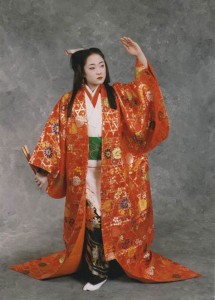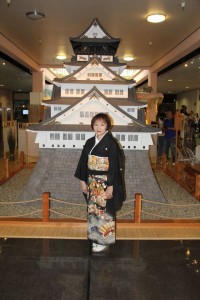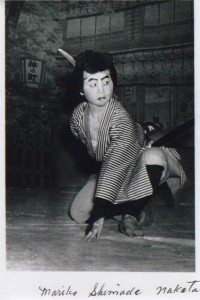
Melanie Mah, dancing “Sen Hime”—she is the daughter of Bando Misayasu, and granddaughter of Masayo Arii
While interviewing the various artists of Japanese cultural arts for the film, I noticed one very important part of all Japanese arts which isn’t discussed as much: the beautiful and exquisite kimono. To tell you the truth, I tried to “ignore” the kimono for a long time. Wearing a kimono in the classic sense is not an easy undertaking. Most modern Japanese don’t even own a kimono, and only wear it for weddings or a funerals, which they often rent or borrow. Generally speaking, buying a kimono is a huge cost. Since I play music, I didn’t think wearing kimono was essential to my performances, and it was time consuming to put on. It constricted my movements, so it made carrying my instrument and equipment cumbersome. Recently, I’ve noticed the kimono has become more of a bathrobe than worn in the elegant traditional style.

Me in my tomesode formal kimono I bought at the flea market in Japan, wearing it for the first time at the Kimono Day in SF Japantown in January 2012
I’ve noticed many kimono shows popping up, selling “antique” kimono and accessories in the U.S. Until I went to Japan in 2011, it didn’t hit me how the kimono has lost its stature in Japanese culture. I heard that one could get some great bargains at the Sunday flea markets, so I visited them while I was in Japan. I found that many of the flea markets were selling beautiful kimono and obi very cheaply, some of them quite ornate. This was “good” for me, in that I was looking for the one style of kimono I didn’t own, that of the very formal “tomesode” kimono, with the family crests on them, and very expensive. When one considers the intricate work of embroidered designs and hand-crafted work on these silk fabrics, I was appalled to find out the kimono I was interested in from the Taisho period, was being sold for 7,000 yen, which was about $80! My husband, Bob, likes to haggle with the vendor, and couldn’t help trying to get her to bring the price down. I was cringing when he got her to 5,000 yen (about $55.00 American). He kept on haggling, and the vendor woman said, “No, I can’t go any lower….but I could throw in this obi sash!” I couldn’t believe it! And then, she went on to say, “I could throw in an ‘obi jime’ cord (which is tied around the obi), too!” My mouth was wide open! (Bob told me not to do that!) While it was a tremendous bargain for me, I felt sad because from this incident, I could tell the kimono has lost its value for several reasons:
—most people don’t wear the kimono in Japan anymore
—it’s not easy to put on
—it’s too expensive
But I feel wearing kimono also has its pluses:
—it’s slimming! As I’m getting older, I think another cool thing about wearing kimono is that for my body, which is losing its curvy shape (sigh!), which is fine for kimono!
—modern kimono doesn’t have to be in a Japanese pattern; new patterns and colors are being used to make the kimono more current
—it’s very elegant in style

The photo of the young “man”, is Mariko Shimada Nakata, a woman, dancing Tsumagoi Dochu, or Tsumagoi Road. The kimono was sewn by her mother with striped material from the May Company in Denver, and maroon obi from the same store. The black leg and hand covering were also sewn by her mother. The “katsura”, or wig, was made by Matsui Sumin, who made the wigs for two dance teachers of the camps (Yukino Harada at Amache, and Bando Mitsusa at Tule Lake). Mariko wrote, “for hair, he took unraveled rope – dyed it with Shinola shoe polish. The metal that formed the scalp was pounded out and also dyed black. The head covering for scalp was made of rayon or silk, and painted nude green/blue, to resemble a bald head. This samurai was not to have bangs, but I insisted upon it, so he found some fur to attach, giving me a more handsome samurai. The waraji (sandals) were made from rope.”
There are some very fun ways to wear kimono, which I’ve been experimenting with, too. For the longest time, I wore kimono dresses, or wrap skirt with a kimono top. I loved this style because it is very versatile: you could wear the kimono top with a turtle neck or blouse, and the wrap skirt could be worn with other blouses, tank tops, etc. You didn’t have to wear an obi with it, but the collar would be too loose if you didn’t wear the obi. I sew a little, so I’m starting to use different patterned fabrics, even making obi and obi jime to go with a variety of patterns, styles and materials.
In the camps, some people would borrow others’ kimono, especially the buyo dancers. One dancer wanted to borrow my grandmother’s wedding kimono. My grandmother reluctantly lent the kimono, but she was worried it would become soiled or damaged. Some people ordered fabrics from Montgomery Ward or Sears, and made them. One of the photos we collected shows kimono made from fabric from a mail order store, and the wig made with stove pipe, combed-out rope, dyed with black Shinola polish.
I took a couple of private lessons on how to put the kimono on myself, but still have difficulty putting the obi on. In the past, I made “ready made obi”, so I wouldn’t have to worry about tying it, but now, I can tell when someone is wearing the “fake” tied obi! Just doesn’t look as nice! But it does make things easier…
I remember reading a New York Times article a couple years back, that said wearing the cotton kimono, or yukata, was getting quite popular, that women were wearing them to the clubs. I thought that was interesting, and wondered if it might be the next Japanese craze, but never saw that developing here in the SF Bay Area. I kinda wish it would. I think if you use some really creative fabrics and combination, it could become very popular. I think I might try that. I’ve made a lot of kimono for my students. I’ll try to be more creative, and have them wear these at our upcoming performances. Any suggestions for pattern combos, colors to match?
Speak Your Mind